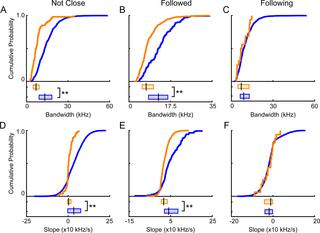PLOS ONE ( IF 3.7 ) Pub Date : 2018-09-21 , DOI: 10.1371/journal.pone.0204527 Megan R Warren 1 , Morgan S Spurrier 1 , Eric D Roth 1 , Joshua P Neunuebel 1

|
Ultrasonic vocalizations (USVs) are believed to play a critical role in mouse communication. Although mice produce USVs in multiple contexts, signals emitted in reproductive contexts are typically attributed solely to the male mouse. Only recently has evidence emerged showing that female mice are also vocally active during mixed-sex interactions. Therefore, this study aimed to systematically quantify and compare vocalizations emitted by female and male mice as the animals freely interacted. Using an eight-channel microphone array to determine which mouse emitted specific vocalizations during unrestrained social interaction, we recorded 13 mixed-sex pairs of mice. We report here that females vocalized significantly less often than males during dyadic interactions, with females accounting for approximately one sixth of all emitted signals. Moreover, the acoustic features of female and male signals differed. We found that the bandwidths (i.e., the range of frequencies that a signal spanned) of female-emitted signals were smaller than signals produced by males. When examining how the frequency of each signal changed over time, the slopes of male-emitted signals decreased more rapidly than female signals. Further, we revealed notable differences between male and female vocal signals when the animals were performing the same behaviors. Our study provides evidence that a female mouse does in fact vocalize during interactions with a male and that the acoustic features of female and male vocalizations differ during specific behavioral contexts.
中文翻译:

自由互动的成年小鼠声音交流的性别差异取决于行为背景
超声波发声(USV)被认为在小鼠交流中发挥着关键作用。尽管小鼠在多种情况下都会产生 USV,但在生殖情况下发出的信号通常仅归因于雄性小鼠。直到最近才有证据表明,雌性小鼠在混合性别互动中也能发出声音。因此,本研究旨在系统地量化和比较雌性和雄性小鼠在动物自由互动时发出的声音。我们使用八通道麦克风阵列来确定哪只老鼠在不受限制的社交互动中发出特定的声音,记录了 13 对混合性别的老鼠。我们在此报告,在二元互动中,女性发声的频率明显低于男性,女性发出的信号约占所有发出信号的六分之一。此外,女性和男性信号的声学特征也不同。我们发现女性发出的信号的带宽(即信号跨越的频率范围)小于男性产生的信号。当检查每个信号的频率如何随时间变化时,男性发出的信号的斜率比女性发出的信号下降得更快。此外,我们还发现,当动物执行相同行为时,雄性和雌性声音信号之间存在显着差异。我们的研究提供的证据表明,雌性小鼠在与雄性小鼠互动时确实会发声,并且雌性和雄性发声的声学特征在特定的行为背景下有所不同。



























 京公网安备 11010802027423号
京公网安备 11010802027423号